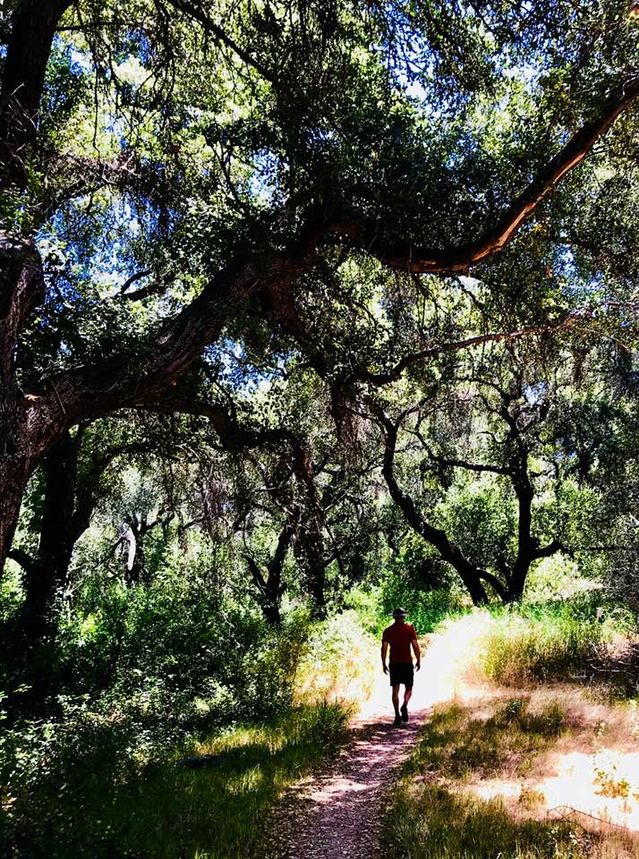Creativity
Want to Be More Creative? Walk Like a Caveman
A simple aspect of the prehistoric lifestyle can boost thinking and creativity.
Posted July 9, 2018

What if I told you that there is one very simple activity that holds the power to boost your mood, refresh your brain for more quality work, and turbocharge creativity as well? It takes as little as twenty minutes, requires no extraordinary skills or fancy equipment, and it’s free. I am referring to the act of putting one foot in front of the other. The technical term for it is “walking.” If you aren’t doing it regularly, you probably aren't getting the best from your brain.
Most people know, of course, that walking is a valuable minimalist exercise that can be relaxing and beneficial to physical health. But how many are aware that science has revealed that where we walk has a significant connection to potential mood and creativity enhancement? Researchers have shown in recent years that walking on a treadmill indoors may be good for the brain but walking outside in a green environment is even better. Green, it turns out, is your brain’s favorite color.
A recent and notable Stanford University project examined what ninety minutes spent walking in a natural landscape did to the brain compared to ninety minutes of walking in an urban environment. A simple, brief walk among trees, bushes, and birds was found to significantly reduce self-reported rumination, the negative and obsessive thought patterns linked to depression and some other mental-health problems. There also was less neural activity in the subgenual prefrontal cortex, an area of the brain associated with social withdrawal in both healthy and depressed people. The test subjects who walked in the city environment did not experience these positive effects.
Walking toward innovation and creation
Creativity lives in the brain. Therefore, to be close to our creative best it is essential that we maintain the healthiest brain possible. This begins with addressing its fundamental needs: proper nutrition, sufficient amounts of quality sleep, and physical activity. (see my book, Good Thinking: What You Need to Know to be Smarter, Safer, Wealthier, and Wiser, for detailed, evidence-based advice on these three needs.) Beyond exercising, eating our vegetables, and getting sufficient sleep per night, another key to achieving good thinking and next-level creativity lies in our past.
Return to your prehistoric roots by taking regular walks in natural environments. This is what we humans did for 99.9 percent of our genus’s existence. Most of our prehistoric ancestors walked often and far. That three-pound blob of electrochemical magic that resides in your skull evolved over millions of year atop a mobile platform that navigated daily within natural environments. Being confined within a concrete box, bathed in artificial light, and enduring a constant bombardment of electronic stimulation is not its natural habitat, not yet anyway. Your Pleistocene brain is in many ways a misplaced and therefore disoriented entity here in the 21st century. So treat it to a regular respite by returning it to a familiar place. Go home. .Be among trees and wildlife, however briefly, for the good of your brain. By the way, no one should dismiss any of this as hippy tree-hugger talk. This is cold, hard science. I am only pointing to the reality of who we were long ago and who we are now.

In my latest book, At Least Know This: Essential Science to Enhance Your Life (Prometheus Books) I address the psychological and physiological benefits of both exercise and exposure to green environments. Too many people are unaware of the helpful and critical scientific knowledge that is available concerning our connection to nature and how nurturing it is to the brain. The link is so profound that one could argue that those who are unable or unwilling to spend time in nature live stunted lives. Green, it now seems clear, is an essential component for an optimal human life that is rich with efficient, productive, and creative thoughts. For example, there is data showing that people tend to be more creative thinkers even after merely being shown the color green on a card as opposed to other colors. That may be somewhat interesting, and nice to know before choosing a color for an art studio, but the bigger lesson from science is that nature can be our best friend when we are burdened with demanding mental work.
In another study, researchers showed the unique value of walking for boosting creativity. They found that 81 percent of test subjects showed significant elevations in creative thought (as measured by a specific test for it) while walking on a treadmill versus being seated. But there’s more. The researchers tested their subjects in a variety of states: sitting, walking on a treadmill, being rolled in a wheelchair outside, and walking outside. Walking outside had the most positive impact on creativity. And the gains occur not only while walking; test subjects exhibited a “residual creative boost” after they had finished a brief walk.

Scientists believe that walking has this effect on the brain because it loosens the restraints and filters that our brains place on memory when we focus on a task. When one dedicates mental effort to something, the brain tries to help by shutting down what it deems to be irrelevant distractions from within. Walking can relax the mind enough to reduce these barriers and allow some unrelated memories to emerge. This is precisely what we want in order to maximize creativity. It helps when disconnected memories and disparate bits of information come forward, because they are often the source of new and unique ideas. Walking outside not only reenergizes the tired mind, but also opens it up to creation and discovery. Therefore, if you want to think well and innovate in the modern world, take some steps back in time and start walking like a caveman straight toward the nearest forest or green space.
For more, read the studies cited in this essay:
- Gregory N. Bratman and J. Paul Hamilton, “Nature Experience Reduces Rumination and Subgenual Prefrontal Cortex Activation,” Proceedings of the National Academy of Sciences 112, no. 28, https://doi.org/10.1073/ pnas.1510459112.
- Gregory N. Bratman et al., “The Benefits of Nature Experience: Improved Affect and Cognition,” Landscape and Urban Planning 138 (June 2015): 41–50, https://doi.org/10.1016/j.landurbplan.2015.02.005 (accessed December 20, 2017); Roger S. Ulrich, Robert F. Simons, Barbara D. Losito, et al., “Stress Recovery during Exposure to Natural and Urban Environments,” Journal of Environmental Psychology 11, no. 3 (September 1991): 201–30, https://doi.org/10.1016/S0272-4944(05)80184-7.
- Marily Oppezzo and Daniel L. Schwartz, “Give Your Ideas Some Legs: The Positive Effect of Walking on Creative Thinking,” Journal of Experimental Psychology 40, no. 4 (2014): 1142–52, http://www.apa.org/pubs/ journals/releases/xlm-a0036577.pdf.
- Stephanie Lichtenfeld, Andrew J. Elliot, et al., “Fertile Green: Green Facilitates Creative Performance,” Personality and Social Psychology Bulletin, Vol 38, Issue 6, 2012.
- Kondo, M. C., Fluehr, J. M., McKeon, T., & Branas, C. C. (2018). Urban Green Space and Its Impact on Human Health. International Journal of Environmental Research and Public Health, 15(3), 445. http://doi.org/10.3390/ijerph15030445
- Song C, Ikei H, et al, “Physiological and Psychological Effects of a Walk in Urban Parks in Fall,” Int J Environ Res Public Health, 2015 Nov 9;12(11):14216-28. doi: 10.3390/ijerph121114216.


